|
Auto
Performance British Rallycross Champion, Keith Ripp British Rallycross Champion, Keith Ripp, has got a bit of a weight problem - at least, his two Auto Performance sponsored, Cosworth BDA engined Fiestas have. Chris Harvey investigates the Ripp-Plan diet 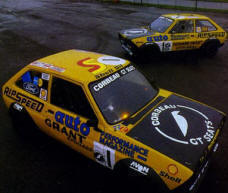 British Rallycross champion, Keith Ripp, says he's got his head together at last! After months deliberating what to do with his two Ford Fiestas, he has made up his mind: the 'old' one - the car with which he won both the 1981 and 1982 British Rallycross Championships overall, is going to get his 2-litre Cosworth BDA engine and the 'new' one will use the 1600 BDA. No matter that they are the other way round at the moment... it was all the result of a bit of a mix-up! British Rallycross champion, Keith Ripp, says he's got his head together at last! After months deliberating what to do with his two Ford Fiestas, he has made up his mind: the 'old' one - the car with which he won both the 1981 and 1982 British Rallycross Championships overall, is going to get his 2-litre Cosworth BDA engine and the 'new' one will use the 1600 BDA. No matter that they are the other way round at the moment... it was all the result of a bit of a mix-up!'We had a heck of a shock when we had to have the 1600 (that's the old car) weighed at the Ingleminster circuit in Belgium last May,' says Keith. 'It came out at 735 kilos, which put it 60 kilos over the small capacity weight limit and only a couple under the larger class.' Until then, Keith had fondly imagined he was keeping to his old policy of having a car as light as possible: less weight, by rule of thumb, is more or less equivalent to extra power. It also means that you can add ballast in desirable places if you are underweight, to give a better performance. Keith bolts his special cast lead ingots to the sumpguard of the Fiesta to keep the extra weight low . . . and to help keep the driven wheels on the ground... 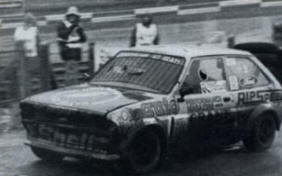 The trouble was, his double championship-winning car looked light. It was based on an ex-Hepolite rolling shell that had been used briefly by Trevor Hopkins. The entire rear end had been cut off and replaced with a glass fibre replica. The lost strength was then regained by a steel space frame structure linked to the roll cage and suspension. Vulnerable bits of bodywork were plated with metal. When Rippy and his mechanics, led by Lea Valley tuning ace, Nick Mason, discovered that they were over the minimum weight limit, they figured out a way of removing a few kilos should they have to build another Fiesta some sunny day. That day came when Keith decided to go up a class and meet the big boys head-on. The resultant 2-litre Fiesta (that's the new one) came out dead on the small car class limit imposed by the Europeans: 650 kilos. So now all they have to do is change everything over when there's time during the hectic season. That will give them a 650 kilo 1600 car for the small class and a 2-litre 735 kilo car for the big class. How did they get the new car down to 650 kilos when it looks just like the old one? The chief difference is that we used a duralumin frame,' says Keith. 'Most of the big boys have gone over from steel now for the obvious reason. Dural is just as strong . . . but it costs three times as much.' But when you consider that an Audi Quattro is rated at £100 000, and its ultra-light, super tough, sumpguard alone costs £3000 - about the price of a competitive clubman's Mini - it's the only way to go at the top. The difference between the 1600 and the 2-litre is fantastic,' says Keith, 'especially as the 2-litre lump is at present in the lighter car, which is legal for British events.' The 1600 gives a reliable 210bhp at 8000rpm... 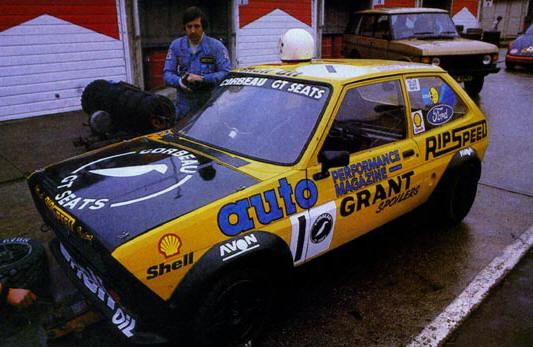 ...with 146lb/ft of torque at 7500; the 2-litre gives 246bhp at 8200rpm and 180lb/ft at 7500. Don't believe the typical pre-race bullshit as rivals wind each other up with tales of 300bhp from a 2-litre Rallycross BDA: it just ain't true... These engines could produce more, but they are built primarily for low-down power with quite mild L1 cams to make them less snatchy. Traction is what the mechanical side of Rallycross is all about and that's where the Ripp-Mason combo comes in. 'I don't think anybody other than Nick has ever got an off-road Fiesta going really well,' says Keith. 'Ford spent a fortune on it, and now they've just said to us: "Do what you please" ..." When it comes to the technical talk, Nick is in his element, a rare breed of expert that can turn it into terms that anybody can understand. The steering is no problem on a Fiesta,' he says. 'We use a lot of castor, but you can still drive it with one hand on the wheel and the other on the gearlever. We set up Keith's car so that when he decelerates it oversteers, and when he accelerates, it understeers... We'd like him to use his hydraulic handbrake more to set up the car into a bend, because Trevor (that's Mr Big Rival Hopkins) is outstandingly good that way. But Keith can't get on with it and seems to get himself out of trouble with his right foot! The only time he used his handbrake he left it on for the rest of the race... but he still won because it was wet and he skidded in with the back wheels locked!' Back to lead-foot Ripp: The big :iesta is fascinating because it really is n the Escort class. The major problem is getting it off the line as fast because it's front-wheel drive; but if you can get up there for a start, you can win because it's faster into the corners. You don't have to throw it at the corners like an Escort...' Back to Mason: 'You can thank our special suspension geometry for that. It's got built-in roll steer and positraction. Sorry, folks, that means that when you brake, the back goes down. It's the opposite to what normally happens with a front-wheel-drive car, when the nose goes down, and it's vital when the back is as light as our car. Come to think of it, a lot of things are the opposite way round on a Rallycross Fiesta. We use three types of brake lining, with the hardest reserved for when it's really wet! The reason for this is because the brakes take longer to warm up with harder linings and as a result they are more progressive on a slippery surface. We keep the soft ones for when it is bone dry... then snatch is not such a problem.' All that BDA power is fed through a steel flywheel and a twin-plate paddle clutch to a standard Hewland Fiesta gearbox. 'It gives no problem provided you don't try to change too quick,' says Keith. 'Slam it in like I did with the dog-clutch box on my old Mini and you're asking for trouble. But it's all right if you pause between gears... and you can do that with the Fiesta because you can drive one-handed, unlike the Mini, where you've really got your hands full.' Comment from Nick: The only thing that's really critical about the box is getting the selection rods right. Their settings are vital.' With his well-known allegiance to Auto Performance, Corbeau seats, Richard Grant spoilers. Shell, Ford, and so on, Keith uses a special Ferguson limited-slip differential. 'It's still a development item, so we hadn't better say too much about it, because it might not be in its final form yet,' says Nick... 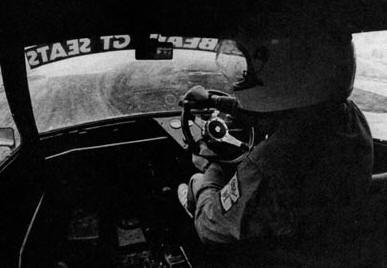 Needless to say, Keith is keen on ratios, using a 5.9:1 and taking off in second with the 1600, then keeping it in third and fourth gear all the way. He started with a 5.9 in the 2-litre at its first meeting at Lydden in September, and then went down to a 5.1 for the Rallycross GP. 'It means that I can take off in third, saving a change, but I think it might still be too high,' says Keith. 'We may go down to a 4.7, which gives a long second gear, meaning you can get your nose ahead of the Escorts as they have to go up to third gear. We may even be able to go down to a 4.5. The difference between the two engines is like chalk and cheese as they are in the cars at the moment. The 1600 revs like mad, up to 10 000; you almost have to learn to drive all over again with the 2-litre. It gets up to a certain point and then stops revving. It's an even bigger problem to get off the line than the 1600.' With Minis in mind, I asked how long his driveshafts lasted... and the answer is that the Group Two devices on the Fiesta are really reliable, as is the rest of the Group Two AVO suspension, with Bilstein shock absorbers, magnesium uprights, four-pot calipers, vented discs, centre-lock wheels, AVO anti-roll bar and pedal box, and high-ratio Quaife rack. 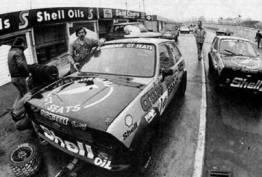 The beam axle four-link back suspension gets bent a bit if Ripp is unlucky, and putting the car back into track is one of the vital between-heats jobs for Nick, his brother, and two other mechanics. The beam axle four-link back suspension gets bent a bit if Ripp is unlucky, and putting the car back into track is one of the vital between-heats jobs for Nick, his brother, and two other mechanics.'We've had to switch to Ford magnesium wheels to get the right inset,' says Keith. They're expensive, because we need four sets to coyer all the tyre options. But our rubber is relatively cheap... only £60 for an Avon cover against half as much again for others. The compound has to be soft, though, and you can't really get more than six meetings out of a set. We've been testing with Avons for two years now and the Fiesta - that's the 1600 one - is faster than a Mini in the dry, but it understeers so much in the wet that it's not so good as a Mini at the moment. But it gets the power down a treat in the dry and then the handling is fantastic. What sort of spring rates do you use? I asked Nick. 'We fit the same ones most of the while,' he says, '- 190lb at the front and 150 at the back, although we go up to 230/200 for very dry tarmac events.' What else do you have to change? The windscreen', moans our Wellington-booted hero, Ripp. 'We've tried everything and we still keep going back to the old slot in the screen. But it's awful trying to drive behind it, even if you can sometimes see better than with a full screen. You get blasted with filth. We're going to have another go at the next Brands meeting with a proper screen and five gallons of liquid forced through a dozen vents by a bilge pump out of a boat, but there have been times when it has bunged up so badly that I've had to stop...' And how does the champion see the future of Rallycross? 'I think we should set up a separate class for up to 1300cc cars or start a formula for lower cost cars,' says Keith. The organisers have been against this in the past because they want to keep Rallycross as the Formula One of off-road racing. But it can cost so much that we are in danger of losing the real club drivers. To support the organisers' view, there is still a tremendous incentive for anybody to get into rallycross. The foreign meetings, for instance, are fantastic, with enormous crowds that generate so much of an atmosphere that it can take you out of yourself.' Sounds good, doesn't it? But too expensive for the likes of you? Well, don't dismiss it just yet because next month we'll reveal how you can get involved in Rallycross for a reasonable amount of money. Same bat time, same bat channel. Written by: Chris Harvey |